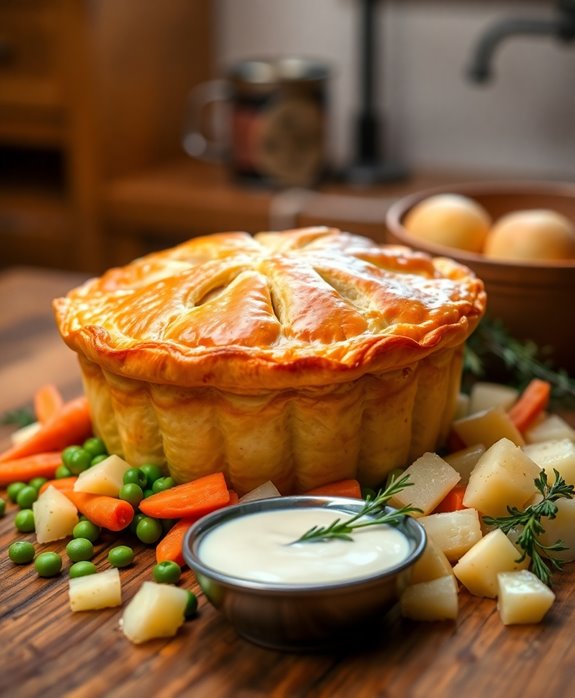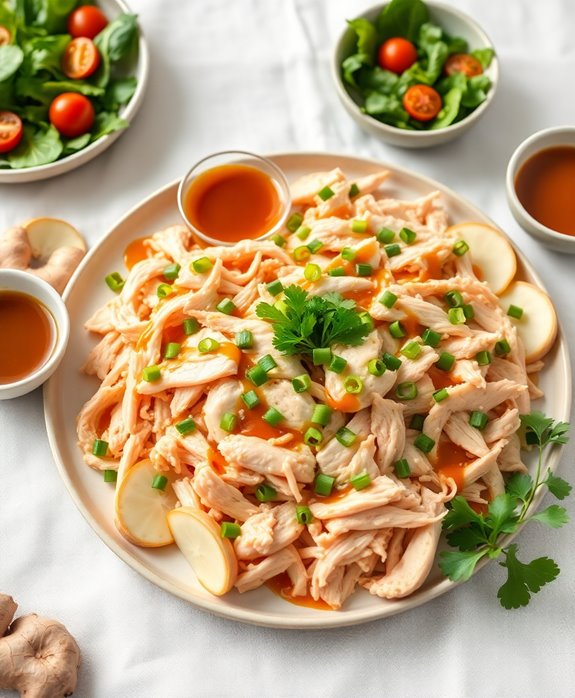Imagine standing at a crossroads, where one path leads to elaborate, time-consuming meals and the other to the straightforward elegance of a perfectly cooked whole chicken. In a carnivore diet, this chicken isn’t just a meal; it’s a celebration of simplicity and flavor. You’ll find that with just a few fresh herbs and careful preparation, this dish can elevate your dining experience remarkably. But what if there’s more to this recipe than just taste? Exploring the nuances of the cooking process may reveal unexpected benefits that go beyond the plate.
Tips and Tricks
- Select a high-quality whole chicken, rinse it under cold water, and pat it dry before cooking for the best flavor.
- Season the chicken with a blend of herbs like rosemary, thyme, and spices such as paprika and garlic powder for a rich taste.
- Truss the chicken to secure the legs and wings, ensuring even cooking and a professional presentation when baked.
- Bake at 375°F for approximately 1 hour, checking that the internal temperature reaches at least 165°F for safety.
- Allow the chicken to rest for 10 minutes before carving to enhance juiciness and flavor distribution throughout the meat.
History
When you think about the history of the carnivore diet, it’s fascinating to see how this approach to eating has evolved over centuries. The roots of this diet can be traced back to ancient cooking practices, where early humans relied heavily on animal products for sustenance.
In hunter-gatherer societies, the reliance on meat was essential for survival, shaping the culinary traditions that would follow. As civilizations developed, various cultures embraced meat as a staple in their diets.
From the indigenous tribes of the Americas who hunted bison, to the nomadic tribes of Mongolia that raised livestock, these ancient practices highlight the significance of animal-based foods in human history. The methods of cooking meat evolved, with techniques like roasting, drying, and smoking becoming commonplace, allowing people to preserve their food and enhance flavors.
Throughout the ages, carnivorous diets have persisted, often intertwined with cultural identity and traditions. Even today, you can see echoes of these ancient practices in modern culinary techniques, reminding us of the deep-rooted connection between our ancestors and the food we consume. The Church’s Chicken recipe is a modern example of how traditional flavors can continue to thrive in today’s kitchens.
The carnivore diet isn’t just a trend; it’s a journey through history.
Recipe

Cooking a whole chicken can be a delightful and satisfying experience, especially when you embrace the carnivore diet. This simple yet flavorful recipe will guide you through the process of preparing a juicy and tender chicken that can be served as the centerpiece for your meal.
Whether you’re hosting a family dinner or enjoying a quiet evening at home, this dish is sure to impress and satisfy your hunger. By following this recipe, you’ll learn how to infuse the chicken with rich flavors while keeping the preparation straightforward. The Golden Corral baked chicken recipe is a great example of how to achieve delicious results with minimal effort.
The key to a successful whole chicken lies in the seasoning and cooking technique, guaranteeing that every bite is packed with taste. Prepare to indulge in a delicious carnivore-friendly meal that will leave you feeling full and satisfied.
Ingredients:
- 1 whole chicken (3-4 lbs)
- 2 tablespoons salt
- 1 tablespoon black pepper
- 1 tablespoon garlic powder
- 1 tablespoon onion powder
- 2 tablespoons olive oil or melted butter
- Fresh herbs (optional, such as rosemary or thyme)
To cook the whole chicken, preheat your oven to 450°F (232°C). Pat the chicken dry with paper towels, then rub it all over with olive oil or melted butter.
Season generously with salt, black pepper, garlic powder, and onion powder, making sure to coat both the outside and the cavity. If desired, place fresh herbs inside the cavity for added flavor.
Place the chicken on a roasting rack in a roasting pan and cook in the preheated oven for about 1 hour, or until the internal temperature reaches 165°F (74°C).
Let the chicken rest for 10-15 minutes before carving. When cooking a whole chicken, it’s important to let it rest after roasting to allow the juices to redistribute for maximum flavor and tenderness.
Additionally, using a meat thermometer is highly recommended to confirm the chicken is cooked to the correct temperature without overcooking. You can also save the bones and leftover meat to make a delicious bone broth, making the most out of your carnivore meal!
Cooking Steps
Now that you’ve gathered your ingredients, it’s time to prepare the chicken for a mouthwatering feast.
You’ll want to thoroughly clean and season it with your favorite herbs and spices, ensuring every bite is packed with flavor. One great option for seasoning is to incorporate savory chicken stuffing, which can enhance the overall taste of the dish.
Once seasoned, truss the chicken securely and get ready to bake it to perfection!
Step 1. Prepare the Chicken Thoroughly

How do you guarantee your whole chicken is ready for a delicious carnivore feast? It all starts with proper chicken preparation.
Begin by selecting a high-quality, fresh chicken—this will ensure rich flavors and juicy meat. Once you have your bird, rinse it under cold water to remove any residual blood or impurities. Pat it dry with paper towels, as moisture can hinder your cooking techniques later on.
Next, inspect the cavity for any leftover giblets or organs. Remove these if present, and don’t forget to rinse the cavity as well. This step is essential for enhancing the overall taste of your dish.
If you plan to truss your chicken, now’s the time to do it. Trussing helps maintain an even cooking temperature throughout the bird, resulting in a beautifully cooked chicken.
For an extra layer of flavor, consider brining your chicken in a simple solution of water and salt for a few hours. This will infuse moisture and improve the texture. Additionally, you might want to smoke chicken thighs to achieve a unique flavor that can be incorporated into your whole chicken preparation.
With these preparation steps completed, you’re ready to move on to cooking techniques that will elevate your carnivore whole chicken to perfection.
Step 2. Season With Herbs and Spices

As you explore the seasoning process, remember that the right blend of herbs and spices can transform your whole chicken into a mouthwatering centerpiece.
Start by choosing herb combinations that complement the chicken’s natural flavors. Fresh herbs like rosemary, thyme, and parsley work wonders, giving your dish an aromatic lift. If you’re using dried herbs, make sure they’re fresh to maintain potency.
Next, consider your spice blends. A combination of paprika, garlic powder, and black pepper can add a delightful kick. For a touch of warmth, include cayenne or chili powder.
Mix these spices in a small bowl, then drizzle some olive oil to create a paste-like consistency.
Rub this flavorful mixture all over the chicken, making sure to work it under the skin for a deeper infusion. Don’t forget to season the cavity—this step enhances flavor throughout the meat.
Allow the chicken to marinate for at least an hour, or better yet, overnight in the fridge. This resting period lets those herb combinations and spice blends develop into an irresistible flavor profile, ensuring every bite is a savory delight. Additionally, incorporating Parmesan crusted chicken can elevate the taste further, adding a crispy texture that complements the tender meat.
Step 3. Truss the Chicken Securely

Trussing your chicken securely is an essential step that guarantees even cooking and helps maintain its juicy texture.
Start by gathering your kitchen twine, a pair of scissors, and your beautifully seasoned chicken. Lay the chicken breast side up on a cutting board. The first step in your trussing technique is to tuck the wing tips under the body. This not only prevents them from burning but also helps the chicken cook evenly.
Next, take the twine and cut a length of about three feet. Position the twine under the chicken’s legs, pulling both ends up and crossing them over the body. Bring the ends back around and tie them together, ensuring it’s snug but not overly tight. This secures the legs, keeping the stuffing (if you’re using any) intact and the meat juicy.
For a final touch, wrap the twine around the chicken a couple of times, securing the legs and wings to the body. This chicken preparation step not only looks professional but also enhances the overall cooking process. Trussing also helps prevent the chicken from falling apart during cooking, allowing for a more cohesive presentation when serving stuffed chicken.
With your chicken trussed securely, it’s ready for the next delicious stage of its journey!
Step 4. Bake at 375°F for 1 Hour

Now that your chicken is beautifully trussed, it’s time to bake it to perfection. Preheat your oven to a steady 375°F; this temperature is ideal for achieving a juicy interior and crispy skin.
Once your oven is ready, carefully place the chicken on a roasting rack in a baking dish, guaranteeing it’s positioned breast-side up. This allows hot air to circulate evenly around the bird.
Set the cooking time for one hour and resist the urge to open the oven door too often. Each time you do, you let precious heat escape, potentially extending the cooking time.
As the chicken bakes, the aromas will fill your kitchen, creating an irresistible atmosphere that’ll have everyone keenly anticipating dinner. Remember that Southern chicken and rice is a classic dish that pairs wonderfully with roasted chicken.
After 60 minutes, check the internal temperature using a meat thermometer inserted into the thickest part of the thigh; it should reach at least 165°F to confirm it’s fully cooked.
If you find the skin isn’t as golden as you’d like, feel free to broil it for a few minutes, keeping a close eye to prevent burning. Your patience will be rewarded with a deliciously roasted chicken that’s ready to impress!
Step 5. Rest for 10 Minutes

After the chicken has baked to perfection, it’s important to let it rest for 10 minutes before carving. This resting period isn’t just a suggestion; it’s essential for maximizing the rest benefits. When you pull the chicken from the oven, the juices are bubbling and anxious to escape. By allowing it to rest, you give those juices a chance to redistribute throughout the meat, leading to a juicier and more flavorful bite.
During this time, the chicken continues to cook slightly, which can enhance the overall texture. The result? A tender, succulent piece of poultry that’s bursting with flavor. If you carve immediately, you risk losing those precious juices that have gathered near the surface.
Instead, let the bird sit, covered loosely with foil to retain warmth, while you prepare your side dishes or set the table.
As you wait, you’ll notice the enticing aroma wafting through your kitchen, building anticipation. This moment is significant for achieving that perfect balance of taste and texture. Additionally, the Sherry Parmesan flavor in the dish can be even more pronounced after resting, enhancing your overall dining experience.
Trust the process; the extra 10 minutes will be worth it when you dig into that beautifully rested, flavorful chicken.
Nutrition Facts
When it comes to the nutrition facts of a carnivore whole chicken, you’ll find a powerhouse of protein packed into every juicy bite. This delectable dish typically boasts about 25-30 grams of protein per 100 grams of chicken, making it an excellent choice for those looking to increase their protein content. That high protein level plays a crucial role in muscle repair and growth, keeping you energized throughout the day.
But it’s not just the protein that makes this meal a winner. Whole chicken is also rich in essential vitamins and minerals. For instance, you’ll reap the vitamin benefits from B vitamins like niacin, which aids in metabolism, and B6, important for brain health.
Additionally, it’s a great source of phosphorus and selenium, both essential for strong bones and immune function. The leftover smoked chicken can be transformed into delicious dishes like savory casseroles that make the most of its rich flavor.
What’s more, when you enjoy the skin, you’re indulging in healthy fats that can help keep you satiated, giving you the energy you need.
Final Thoughts
Savoring a carnivore whole chicken not only satisfies your taste buds but also fuels your body with a wealth of nutrients. When you prepare this dish, you’re not just cooking; you’re engaging in a journey of flavors and textures that celebrate the essence of the carnivore diet. The golden, crispy skin, paired with tender, juicy meat, creates a mouthwatering experience that’s hard to resist.
Incorporating this chicken into your meal planning can simplify your week while ensuring you enjoy a variety of flavor combinations. Think of the herbs and spices you can experiment with, like rosemary, garlic, or smoked paprika, to elevate your dish. Additionally, serving it alongside sides such as chicken cordon bleu meatloaf can introduce delightful contrasts in flavor and texture.
Each meal can be a new adventure, from hearty chicken salads to rich, savory broth that warms the soul.
As you embrace this wholesome recipe, you’ll notice how it encourages creativity in the kitchen. The versatility of a whole chicken opens doors for delightful leftovers, perfect for quick lunches or dinners.
Frequently Asked Questions
Can I Use Frozen Chicken for This Recipe?
Imagine pulling a frosty chicken from your freezer, ready to transform into a delicious meal. You can use frozen chicken, but remember to thaw it safely using methods like refrigeration, cold water, or microwave before cooking.
What Side Dishes Pair Well With Carnivore Whole Chicken?
For your chicken, consider creamy garlic sauce or zesty chimichurri. Seasoning ideas like rosemary, thyme, or smoked paprika elevate flavors beautifully. These options enhance your meal, making it even more delicious and satisfying for everyone.
How Do I Store Leftovers Properly?
Did you know proper leftover storage can reduce food waste by up to 30%? For chicken safety, refrigerate leftovers in airtight containers within two hours. Consume within three to four days for the best quality.
Can I Substitute Chicken With Other Meats?
You can substitute chicken with various chicken alternatives like turkey or duck. Each meat brings unique flavors and meat textures, enriching your dish while keeping it deliciously satisfying. Experiment and discover your favorites!
Is This Recipe Suitable for Meal Prep?
This recipe’s perfect for meal prep! You’ll relish the meal prep benefits, as it aligns seamlessly with the carnivore diet, providing tasty, protein-rich meals ready for your busy week ahead. Enjoy the convenience!







